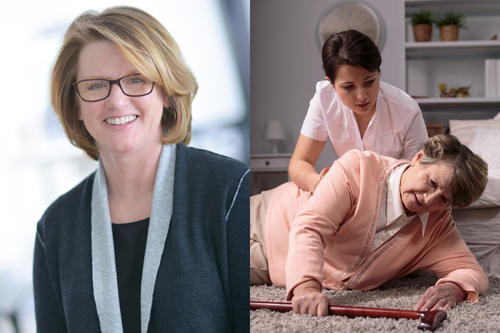
This year, September 21 to 25 is Falls Prevention Awareness Week to bring awareness of reducing falls — which can cause life-changing injuries — in older adults through preventative practices.
According to the Centers for Disease Control and Prevention (CDC), approximately one in four adults age 65 and older, report falling each year. About 37% of those who fall reported needing medical treatment or restriction in activity afterward. Siobhan McMahon, Ph.D., MPH, with the University of Minnesota School of Nursing explains how physical activity in older adults can help prevent falls and related injuries.
Q: What are the risk factors for injurious falls among older adults?
Prof. McMahon: There are several risk factors for injurious falls that can be modified, some more significant than others. For example, changes in walking gait, and balance and strength are significant, interrelated risks. Other risk factors include pain, visual changes (e.g., cataracts), the use of medications that increase fall-risk, osteoporosis, postural hypotension, and environmental hazards (e.g., poor lighting, thick carpet).
Q: How does physical exercise help prevent falls in older adults and related injuries?
Prof. McMahon: According to a 2019 study, physical exercise that focuses on strength and balance is the one intervention that has been found to reduce injurious falls on its own. Performing these physical exercises at least three times per week helps to build and maintain a person’s balance and leg strength. In turn, better balance and leg strength make it easier to walk on uneven surfaces and to correct slips, trips or stumbles.
Q: What can friends, family, health care providers and caregivers do to help prevent or reduce the risk of falls?
Prof. McMahon: Partner to do four things on a regular basis. The first and most effective thing to do is to encourage and support movement and the inclusion of leg-strengthening and balance-challenging movements into everyday life and adjusted according to personal ability and preferences. There are many videos and programs (e.g., Silver Sneakers) available online to help people get started at home. Many people do these exercises with others, but remotely, such as over the phone or through Zoom. Second, get annual eye exams. These are important because they enable an eye doctor to identify and help people manage eye problems that are associated with falls (e.g., cataracts). Third, regularly check and ensure that environmental hazards are minimized (e.g., correct dim lighting, clear clutter) and that aids are readily available when needed (e.g., bathroom grab bars). Finally, self-assess risk factors for injurious falls and discuss that assessment with primary care providers. The CDC has a brochure that guides this assessment titled “Stay Independent.”
Q: How has education on fall prevention changed with the pandemic?
Prof. McMahon: During the pandemic, the need for prevention efforts have not changed — they are still critical. However, several programs have paused because they rely on gatherings of six or more individuals in one location. Fortunately, education and fall prevention efforts can be done independently and at home. Also, some programs have successfully shifted to delivery via telephone or computer. For example, Juniper and Fairview have shifted the Tai Ji Quan balance program to Zoom. Hopefully, more fall prevention programs and efforts will adapt to COVID-19-related restrictions so they are accessible to all older adults with fall risk.
Q: How is your research working towards improving fall prevention in older adults?
Prof. McMahon: My research builds on the evidence that balance and strength physical exercises reduce falls. This evidence provides healthcare professionals with knowledge about which physical exercises to promote. However, despite efforts to disseminate this knowledge, most older adults do not perform these physical exercises. One reason for this is that little is known about which strategies motivate older adults to exercise regularly. Due to this, my research focuses on developing and identifying strategies that can be used by nurses and other healthcare professionals to help older adults stay motivated and include fall-reducing physical activities into their everyday life.
Siobhan McMahon is an associate professor in the School of Nursing and a cooperative member of Adult and Gerontological Health. Her research focuses on promoting health and wellness in older adults, especially those at risk of falling. McMahon develops community-based physical activity and fall prevention interventions for older adults. Her current study assesses the relative effects of behavior change strategies on older adults’ physical activity.
###
About “Talking...with U of M”
“Talking...with U of M” is a resource whereby University of Minnesota faculty answer questions on current and other topics of general interest. Feel free to republish this content. If you would like to schedule an interview with the faculty member or have topics you’d like the University of Minnesota to explore for future “Talking...with U of M,” please contact University Public Relations at unews@umn.edu.
"activity" - Google News
September 21, 2020 at 07:00PM
https://ift.tt/3iS4cPs
Talking fall prevention in older adults through physical activity with U of M - UMN News
"activity" - Google News
https://ift.tt/3ddCXMh
https://ift.tt/2WkO13c
Bagikan Berita Ini














Haloo kami datang lagi dengan program menarik hanya 20 rb bisa dapatin hadiah jutaan rupiah penasaran
ReplyDeleteyuk bergabung dengan kami di DEWALOTTO ya buruan... :)
ADD WA +855 888765575 Terima Kasih admint...:)